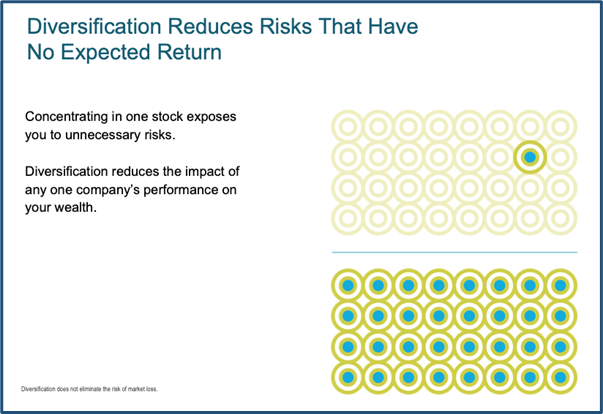
Evidence-Based Investing Insights: Managing the Market’s Risky Business
Welcome to the next installment in our series of Oasis Wealth Planning’s Evidence-Based Investment Insights: Managing the Market’s Risky Business.
In our last piece, “The Full-Meal Deal of Diversification,” we described how effective diversification means more than just holding a large number of accounts or securities. It also calls for efficient, low-cost exposure to a variety of capital markets from around the globe. Today, we’ll expand on the benefits of diversification, beginning with its ability to help you better manage investment risks.
There’s Risk, and Then There’s Risk
Before we’re old enough to have words to describe it, most of us learn about life’s general risks when we tumble into the coffee table or reach for that pretty cat’s tail. Investment risks aren’t as straightforward. Here, it’s important to know that there are two, broadly different kinds of risks: avoidable risks and unavoidable risks. Avoidable risks tend to arise from a concentrated position, like owning a single stock, and unavoidable risks tend to apply to broader markets.
Avoidable Risks from Concentrated Holdings
Concentrated risks are the ones that wreak havoc on particular stocks, bonds or sectors, but do not affect the entire market. Even in a bull market, one company can experience an industrial accident, causing its stock to plummet. A municipality can lose a major manufacturing plant and default on a bond even when the wider economy is thriving. A natural disaster can strike all companies in an industry or region while the rest of the world thrives.
In the science of investing, concentrated risks are considered avoidable. Accidents and natural disasters still happen, but you can dramatically minimize its impact on your investments by diversifying your holdings widely and globally, as we described in our last post. When you are well diversified, if some of your holdings are affected by a concentrated risk, the damage done to your portfolio is limited to a small allocation, and your other holdings are unaffected.

Unavoidable Market-Related Risk
If concentrated risks are like bolts of lightning, market-related risks are encompassing downpours in which everyone gets wet. They are the persistent risks that apply to large swaths of the market. At their highest level, they are the ones you face by investing in capital markets in any way, shape, or form. If you stuff your cash in a safety deposit box, it will still be there the next time you visit it. (It’s purchasing power may be less due to inflation, but that’s a different risk, for discussion on a different day.) Invest in the market and, presto, you’re exposed to market risk.
Risks and Expected Rewards
Hearkening back to our past conversations on group intelligence, the market as a whole knows the differences between avoidable and unavoidable investment risks. Heeding this wisdom guides us in how to manage our own investing with a sensible, evidence-based approach.
Managing Concentrated Risks
If you try to beat the market by chasing particular stocks or sectors, you are exposing yourself to higher concentrated risks that could have been avoided with diversification. Since the market knows that this risk can be diversified away it does not reward such risk. As such, you cannot expect to be consistently rewarded with returns for taking on concentrated risks.
Managing Market-Related Risks
Every investor faces market risks that cannot be “diversified away.” Those who stay invested when a market’s risks are on the rise can expect to eventually be compensated for their steely resolve with higher returns. But they also face higher odds that results may deviate from expectations, especially in the near-term. That’s why you want to take on as much market risk that is personally necessary, but no more. Diversification becomes a “dial” for setting the right volume of market-risk exposure for your individual goals.
Your Take-Home
Whether we’re talking about concentrated or market-related risks, diversification plays a key role. Diversification is vital for avoiding concentrated risks. In managing market risks, it helps you adjust your desired risk exposure to reflect your own purposes. It also helps minimize the total risk you must accept as you seek to maximize expected returns.
This sets us up well for our next piece, in which we address another powerful benefit of diversification: smoothing out the ride along the way.

